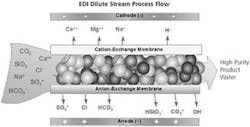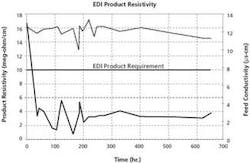EDI polishes evaporator water at Texas power plant
By Ted Prato and Robert Muller
Operating and chemical costs improved significantly at the Guadalupe Power Plant in the US state of Texas after an electrodeionisation (EDI) system replaced on-site regenerated ion exchange resin beds in the power plant water treatment system. Designed for zero liquid discharge (ZLD), the water treatment system includes an evaporator that processes cooling tower blowdown, mainly for wastewater concentration.
EDI further refines high-quality condensate from the evaporator; however the condensate created new challenges in terms of feed composition and temperature range for the EDI process.
EDI replaces traditional on-site regenerated demineralisation with ion exchange resin after the evaporator, which reduced environmental liability associated with acid and caustic regeneration of the IX resin beds.
Natural gas fuels the power plant that can deliver approximately 1,000 mW of electric power. Two identical power generation units are each composed of two combustion turbines: one steam turbine and a cooling tower. The two cooling towers are supplied with softened raw water from two identical clarifiers. A common wastewater treatment and recovery system is integrated into the plant to supply high purity demineralised water for boiler feed, a small portion of which is used for cooling tower makeup.
Zero liquid discharge has become a common approach employed to meet increasingly strict environmental wastewater discharge regulations. Evaporation followed by crystallisation reduces dissolved minerals to dry salts that can be easily disposed of in landfills.
Guadalupe water treatment system
The water treatment facilities are composed of two trains. The raw water supply system consists of two raw water clarifier-type softeners. The wastewater treatment section consists of an evaporator, a crystalliser and an EDI system followed by ion exchange polishing.
The cooling towers receive makeup water from the softeners. As a result of the cooling process, dissolved solids are concentrated before being discharged as blowdown. The evaporator and crystalliser further concentrate the cooling tower blow down (CTBD). The recovered distillate from the evaporator/crystalliser is further processed in the EDI system to produce high purity water for the boilers. Excess distillate (condensate) becomes cooling tower makeup.
Cooling tower operation sets key parameters such as flow rate and concentration that must be controlled by the water treatment systems to maintain zero liquid discharge status. In essence, the cooling tower evaporation rate determines the total volume of water that is supplied to the plant facility, and the chemistry of the raw water combined with the softening operation determines the volume of CTBD to be processed (by the evaporator). The raw water softener removes calcium from the CTMU to allow higher cycles of concentration to be achieved in the cooling water circuit. A small amount of magnesium and silica are also removed. The resulting CTBD is evaporated using a compressor-driven seeded slurry evaporation process.
Evaporator operation
The treatment of cooling tower blowdown is accomplished in two evaporative steps. The first step evaporates the majority of the wastewater (greater than 97%) to distillate in a falling film type evaporator. High-quality distillate produced in the first evaporation stage is used as feed to the EDI system. Excess distillate is sent to the cooling towers as makeup. The evaporator uses an energy-efficient vapour compression cycle. The compressor energy source is electricity.
Concentrated brine from the evaporator is evaporated to crystal cake in a Calandria-type crystalliser. Solids from this device are separated from the crystalliser brine slurry with a belt pressure filter for disposal offsite as non-hazardous material. The crystallisation step is a slow evaporative process, necessary to initiate crystal growth. This process is heated with steam generated from a natural gas-fired boiler system as the energy source.
EDI operation
The EDI section of the water treatment system consists of a single skid containing controls and hydraulics. Connected to the skid are three EDI membrane stacks, each with a nominal product capacity of 50 gpm. This 150-gpm unit operates continuously on demand. The EDI unit operation is initiated manually, but safety protocols are programmed to be automatic. Some critical feed specifications such as temperature and conductivity are monitored on-line to ensure that the EDI unit does not experience off-spec feed. High-purity EDI product is fed to a portable ion exchange resin bottle (regenerated off site), which acts as a final polishing step.
EDI performance
The Guadalupe EDI system, operated intermittently, is online for approximately 8 to 12 hours per day as determined by power plant and evaporator requirements. The main concerns with operating an EDI unit using evaporator condensate as feed are:
• Temperature excursions (potential damage to stack components);
• Slugs of high conductivity from the evaporator (resin and membrane fouling, depolarising of ion exchange resin);
• High organic levels (potential fouling of EDI resin).
EDI product quality has consistently averaged 15 to 16 megohm-cm (product resistivity) with a required spec of 10 megohm-cm. Conductivity removal has also remained at 95% or higher. Feed conductivity to the EDI unit varied from 0.6 to 14 microsiemens/cm (units of conductivity) due to changing evaporator operating conditions.
Evaporators can be subject to periodic events called "foam-overs" in which a slug of high-conductivity material mixes with the normal product stream. When such an event occurs, a programmed safety protocol (high conductivity alarm) shunts the feed to off-spec and the EDI unit shuts down until the feed quality is back within feed requirements.
Temperature is another factor challenging EDI operating limits at the Guadalupe site. The upper limit for feed temperature for EDI stacks is 40°C, so Ionics designed the system to accommodate temperatures up to 45°C. The feed to this EDI unit typically is running in the 28-34°C range. As summer approaches in Texas, this ambient temperature will no doubt increase. The EDI unit will operate normally up to 40°C and even as high as 45°C on evaporator product. If the EDI feed temperature exceeds the limit programmed into the plant logic, the feed is diverted and the unit is shut down until the feed temperature range is within specifications.
Of interest at this site are the high levels of ammonia (483 ppb) and TOC (1,076 ppb) in the feed. The 99.7% ammonia removal represents the highest removal rate of any of the feed constituents.
Sodium and chloride are normally removed by the EDI process in the 99% or higher range, but the low removal levels observed are a function of the relatively low levels in the feed. The TOC removal of 56% is typical of EDI TOC removal rates at other plants. TOC compounds present in this evaporator condensate are typically small since higher molecular weight compounds would be left behind in the evaporator concentrate. EDI product flow is set at 160 gpm.
The power plant facility meets its zero liquid discharge goal. EDI brine blowdown and electrode steam waste are recycled back to the softening clarifiers, which increases EDI percent recovery from the typical 95% up to 100%.
How EDI works
Electrodeionisation is a membrane-based separation process. An EDI system is composed of a stack of flow-directing spacers separated by anion and cation semipermeable membranes. This stack of components is bounded on each end by electrodes, and the entire assembly is held together using the rods, similar to a plate and frame structure.
EDI separates dissolved ionisable components of the feed water by means of a DC electrical field across the stack of components. Ion exchange resin in the diluting compartment assists in scavenging the dissolved salts from the continuous-flow feed stream. Under the influence of the applied DC field, these ionic salts then leave the ion exchange resin and pass through membranes segregated by attraction to their respective, oppositely-charged electrode.
Once the strongly charged dissolved ions have been removed from the feed stream, only relatively pure water remains in the diluting compartment process stream, along with weakly-charged and non-ionised species. Some of this water is then continuously dissociated by the DC electrical field into hydrogen (H+) and hydroxyl (OH-) ions. These positively or negatively charged species migrate to their oppositely charged cation or anion ion exchange resin beads. These sites then take part in ionising reactions of neutral or weakly charged ions, such as silica, ammonia and carbon dioxide.
The EDI process removes and ionises dissolved minerals and gases on a continuous basis with continuous in-place ion exchange regeneration. Feed requirements for the EDI process include limits on divalent ions such as calcium and magnesium that can lead to scaling on the membranes. Other feed limits include total organic carbon (TOC), which can foul IX resin and iron, which will irreversibly bond to IX membranes and resin.
Authors' note
Ted Prato and Robert Muller of Ionics, Incorporated wrote this article along with Freddy Alvarez of Texas Independent Energy, based in Guadalupe County, Texas. Texas Independent Energy was formed in 1999 as a 50-50 joint venture between Guadalupe Energy International Inc. of Dallas, Texas and PSEG Global of New Jersey, U SA. Ionics is based in Watertown, Massachusetts, USA.



